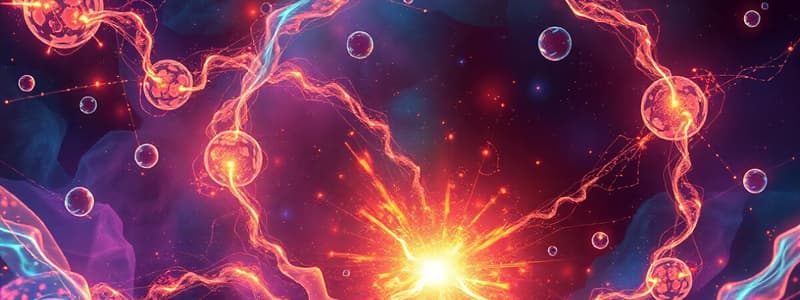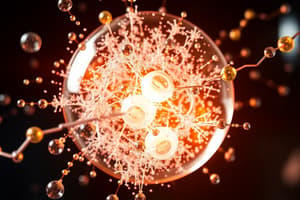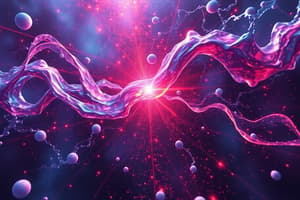Podcast
Questions and Answers
What is the primary function of a catalyst in a chemical reaction?
What is the primary function of a catalyst in a chemical reaction?
- To increase the temperature of the reaction
- To decrease the concentration of reactants
- To lower the activation energy required for the reaction (correct)
- To be consumed during the reaction
How do enzymes function as catalysts in biological reactions?
How do enzymes function as catalysts in biological reactions?
- By stabilizing the products of the reaction
- By breaking down reactants into smaller components
- By increasing the volume of reactant molecules
- By aligning reactant molecules for better collisions (correct)
What is a characteristic feature of enzymes?
What is a characteristic feature of enzymes?
- They are temperature-sensitive and specialized (correct)
- They function optimally at a fixed temperature regardless of conditions
- They are insensitive to temperature changes
- They can be produced in unlimited quantities
What role does salivary amylase play in digestion?
What role does salivary amylase play in digestion?
What would likely happen to chemical reactions in living organisms without enzymes?
What would likely happen to chemical reactions in living organisms without enzymes?
What defines the rate of a chemical reaction?
What defines the rate of a chemical reaction?
Which example demonstrates a low reaction rate?
Which example demonstrates a low reaction rate?
What is activation energy?
What is activation energy?
Which factor does NOT affect the rate of chemical reactions?
Which factor does NOT affect the rate of chemical reactions?
How can the rate of a reaction be increased?
How can the rate of a reaction be increased?
What effect does temperature have on reaction rates?
What effect does temperature have on reaction rates?
Which of the following is a consequence of increased surface area in a reaction?
Which of the following is a consequence of increased surface area in a reaction?
What role does a catalyst play in a chemical reaction?
What role does a catalyst play in a chemical reaction?
What effect does increasing temperature have on the reaction rate?
What effect does increasing temperature have on the reaction rate?
How is concentration defined in the context of reactions?
How is concentration defined in the context of reactions?
Why does increasing surface area lead to a higher reaction rate?
Why does increasing surface area lead to a higher reaction rate?
What is the relationship between reaction rate and concentration?
What is the relationship between reaction rate and concentration?
Which method can be used to increase surface area?
Which method can be used to increase surface area?
What role do catalysts play in chemical reactions?
What role do catalysts play in chemical reactions?
How does the physical state of a substance affect its concentration?
How does the physical state of a substance affect its concentration?
Which statement correctly explains the relationship between particle collisions and reaction rates?
Which statement correctly explains the relationship between particle collisions and reaction rates?
Flashcards
Rate of reaction
Rate of reaction
How quickly or slowly reactants turn into products
High reaction rate
High reaction rate
A reaction that happens quickly
Low reaction rate
Low reaction rate
A reaction that happens slowly
Collision Theory
Collision Theory
Signup and view all the flashcards
Activation energy
Activation energy
Signup and view all the flashcards
Increasing collisions
Increasing collisions
Signup and view all the flashcards
Increasing kinetic energy
Increasing kinetic energy
Signup and view all the flashcards
Temperature's effect on reaction rate
Temperature's effect on reaction rate
Signup and view all the flashcards
Catalyst
Catalyst
Signup and view all the flashcards
Enzyme
Enzyme
Signup and view all the flashcards
Temperature sensitivity of enzymes
Temperature sensitivity of enzymes
Signup and view all the flashcards
Importance of enzymes
Importance of enzymes
Signup and view all the flashcards
Effect of Temperature on Reaction Rate
Effect of Temperature on Reaction Rate
Signup and view all the flashcards
Concentration and Reaction Rate
Concentration and Reaction Rate
Signup and view all the flashcards
Concentration Definition
Concentration Definition
Signup and view all the flashcards
Surface Area and Reaction Rate
Surface Area and Reaction Rate
Signup and view all the flashcards
Surface Area Example
Surface Area Example
Signup and view all the flashcards
Reaction Rate Increase by Surface Area
Reaction Rate Increase by Surface Area
Signup and view all the flashcards
Collision and Reactions
Collision and Reactions
Signup and view all the flashcards
Study Notes
Factors Affecting Reaction Rate
- Rate of reaction: How quickly reactants turn into products
- Fast reaction = high reaction rate
- Slow reaction = low reaction rate
- Examples: explosion (fast), rusting (slow)
Collision Theory
- Reactions occur when particles collide
- Particles must collide with sufficient energy for reaction to occur
- Activation energy: Minimum kinetic energy needed for reaction
- Particles need enough energy to break bonds in reactants
Factors Affecting Reaction Rate (Main Four)
-
Temperature:
- Higher temperature = more energy = faster movement of particles = more frequent collisions = faster reaction
- Lower temperature = less energy = slower movement of particles = fewer collisions = slower reaction
-
Concentration:
- Higher concentration = more particles in a given volume = more frequent collisions = faster reaction
- Lower concentration = fewer particles = fewer collisions = slower reaction
-
Surface Area:
- Larger surface area = more exposed particles = more frequent collisions = faster reaction
- Smaller surface area = fewer exposed particles = fewer collisions = slower reaction
-
Catalysts:
- Substances that speed up reaction rate without being consumed
- Catalysts lower activation energy, making reactions easier
- Enzymes: Biological catalysts in living organisms (e.g., salivary amylase)
Studying That Suits You
Use AI to generate personalized quizzes and flashcards to suit your learning preferences.



